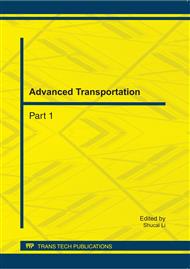[1]
X.J. Deng, X.M. Huang, in: Principles and Design Methods of Pavement, edited by Y.F. Liu, volume 7 of Design Method of Rigid pavement, chapter, 12, China Communications Publishers, Beijing, China (2007), pp.472-478(In Chinese).
Google Scholar
[2]
W. Huang, Z.D. Qian, in: Theory and Methodology of High-Class Concrete Pavement Design, volume 1 of Design of Continuously Reinforced Concrete Pavement, chapter, 4, China Communications Publishers, Beijing, China (2000), pp.206-212(In Chinese).
Google Scholar
[3]
Ministry of Communications, in: Specification of Cement Concrete Pavement Design for Highway(JTG D40-2002), China Communication Press, Beijing, China (2003) (In Chinese).
Google Scholar
[4]
X.Y. Gu, Q. Dong and F.J. Ni: Research on Crack Progression of Continuously Reinforced Concrete Pavement, Journal of Highway and Transportation Research and Development, Vol. 6 (2007), pp.37-40(In Chinese).
Google Scholar
[5]
AASHTO, in: Standard Specifications for Transportation Materials and Methods of Sampling and Testing, Washington DC: AASHTO(1989).
Google Scholar
[6]
M.I. Darter, J.M. Becker, M.B. Snyoer, et al. Portland Cement Concrete Pavement Evaluation System(COPES), Washington DC: Transportation Research Board(1985).
Google Scholar
[7]
M. Won, C. Medina. In: Analysis of Continuously Reinforced Concrete Pavement Behavior Using Information in the Rigid Pavement Database. Austin, TX: Center for Transportation Research of the University of Texas at Austin(2008).
Google Scholar
[8]
Y.J. Jiang, X.Z. Dai, Z.D. Chen, et al. Study on Mechanism of Cement Concrete Pavement Damage of Heavy—Duty Traffic Road and Countermeasures, Journal of Highway and Transportation Research and Development, Vol. 7 (2005), pp.31-35(In Chinese).
Google Scholar
[9]
Department of Mathematics of Tongji University, in: Higher Mathematics(Volume II), edited by S. Guo, volume 7 of Fourier Series, chapter, 11, Higher Education Press, Beijing, China (1996), pp.293-309(In Chinese).
Google Scholar
[10]
Y.Z. Guo, Z.H. Zhou, in: Theoretical Mechanics, Tsinghua University Press, Beijing, China (2005), pp.12-15(In Chinese).
Google Scholar
[11]
X.Y. Wang, J.Y. Xiao, Y.Z. Tang et al, in: Mechanics Analysis and Design of Composites, edited by Q. Luo, volume 4 of Micromechanics of Composite Materials, chapter, 4, National University of Defense Technology Press, Changsha, China (1999), pp.100-118(In Chinese).
Google Scholar
[12]
Department of Mathematics of Tongji University, in: Higher Mathematics(Volume I), edited by S. Guo, volume 5 of Higher Order Derivatives, chapter, 2, Higher Education Press, Beijing, China (1996), p.124(In Chinese).
Google Scholar
[13]
X.F. Sun, X.S. Fang and L.T. Guan, in: Mechanics of Materials, volume 7 of Stress and Deformation of Straight Bar with Uniform Cross Section Under Free Torsion, chapter, 3, Higher Education Press, Beijing, China (1990), pp.132-133(In Chinese).
Google Scholar
[14]
M.Z. Wang, W. Wang and J.K. Wu, in: Theory of Elastic Mechanics, edited by S.Q. Qiu, volume 9 of Torsion of Rectangular Cross Section, chapter, 6, Peking University Press, Beijing, China (2002), pp.146-150(In Chinese).
Google Scholar
[15]
Ministry of Communications, in: Code for Design Highway Reinforced Concrete and Prestressed Concrete Bridges and Culverts(JTG D62-2004), China Communication Press, Beijing, China (2004) (In Chinese).
Google Scholar


